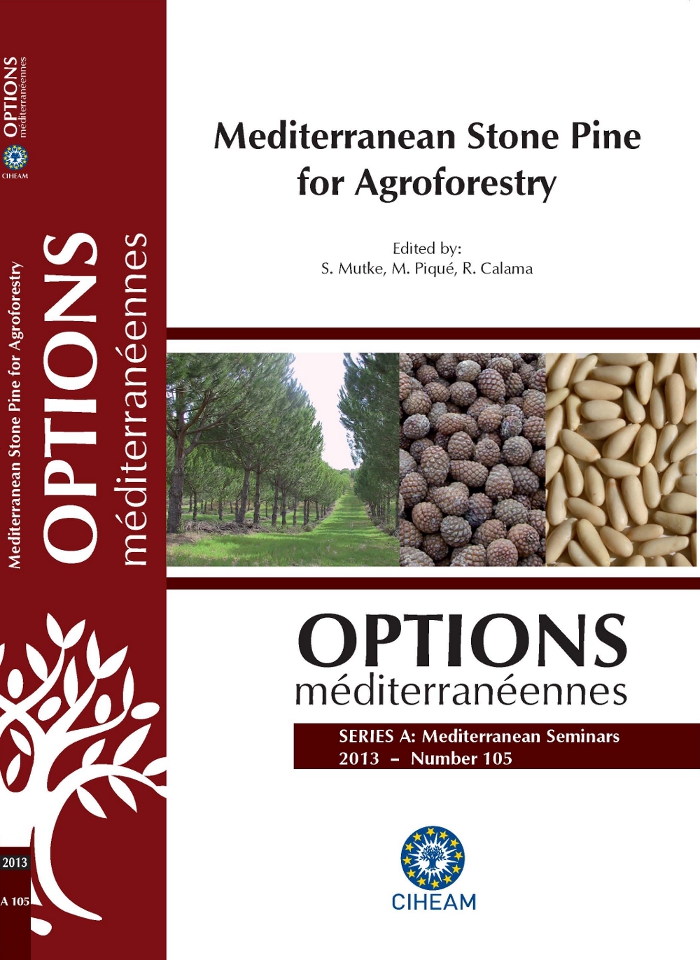| Article précédent | p. 29-33 | Article suivant |
Effects of pests and diseases on stone pine (Pinus pinea L.) conelet losses in Kozak catchment area
Kozak catchment area is in Bergama District in İzmir, a bowl shaped area with 16,000 hectare stone pine forest which forms one-third of the total stone pine area in Turkey. Almost all the forest area is private. In recent years, conelet losses of stone pine have been increased. To investigate the relation between the losses and pest-disease effects, 8 different sample areas were examined during 2005–2008. The results showed that almost all cone losses occurred in new conelets. In the cone losses, significant differences were found between years and sample areas. But neither a pest nor a disease was found as the effect of the high losses. The most abundant insect species on two and three aged cones was Dioryctria pineae Staudinger (Lep., Pyralidae). Damage rate of this pest was 3% in some areas. Other pests were identified as Ernobius pini (Col., Anobiidae), Camptomyia pinicola (Dipt. Cecidomyiidae), Cicada sp. (Hom., Cicadidae), Apterygothrips priesneri zur Strassen (Thys., Phlaeothripidae) and Neohydatothrips gracilicornis (Williams) (Thys., Thripidae). And some pests and diseases which caused indirect conelet losses –making some damages on shoots– were identified as Tomicus sp. (Col., Curculionidae), Sordaria sp. and Pestalotiopsis sp.
Le bassin hydrographique de Kozak se trouve dans la zone de Bergama, Izmir, une superficie en forme de cuvette de 16 000 hectares de forêts de pins pignons qui constitue un tiers de la surface totale de pins pignons de la Turquie. Presque toute la surface forestière est de propriété privée. Dernièrement, les pertes de jeunes cônes de pins pignons se sont accrues. Pour étudier le rapport entre ces pertes et les effets des ravageurs et maladies, 8 différentes parcelles d'échantillonnage ont été examinées sur les années 2005–2008. Les résultats ont montré que presque toutes ces pertes avaient lieu sur les jeunes cônes. Des différences significatives quant aux pertes de cônes ont été trouvées entre années et parcelles d'échantillonnage. Mais aucune maladie ni ravageur ne s'est avéré être la cause de ces fortes pertes. L'espèce la plus abondante d'insectes sur les cônes de deux ou trois ans d'âge était Dioryctria pineae Staudinger (Lep., Pyralidae). Le taux de dommages de ce ravageur était de 3 % dans certaines zones. D'autres ravageurs ont été identifiés comme étant Ernobius pini (Col., Anobiidae), Camptomyia pinicola (Dipt. Cecidomyiidae), Cicada sp. (Hom., Cicadidae), Apterygothrips priesneri zur Strassen (Thys., Phlaeothripidae) et Neohydatothrips gracilicornis (Williams) (Thys., Thripidae). Et certains ravageurs et maladies qui causaient des pertes indirectes de jeunes cônes – provoquant quelques dégâts sur les bourgeons – furent identifiés comme Tomicus sp. (Col., Curculionidae), Sordaria sp. et Pestalotiopsis sp.
- [ Afficher ]
- [ Télécharger ]
- [ Exporter la citation ]
Vous pouvez télécharger la citation au format :
- [ Imprimer ]
-
Mots-clés
AGROFORESTERIE, PERTE DE RENDEMENT, PINUS PINEA, RAVAGEUR DES PLANTES, CONECiter cet article
Özçankaya I.M., Balay S.N., Bucak C. Effects of pests and diseases on stone pine (Pinus pinea L.) conelet losses in Kozak catchment area. In : Mutke S. (ed.), Piqué M. (ed.), Calama R. (ed.). Mediterranean stone pine for agroforestry. Zaragoza : CIHEAM / FAO / INIA / IRTA / CESEFOR / CTFC, 2013. p. 29-33. (Options Méditerranéennes : Série A. Séminaires Méditerranéens; n. 105). AGROPINE 2011 International Meeting on Mediterranean Stone Pine for Agroforestery, 2011/11/17-19, Valladolid (Spain). http://om.ciheam.org/om/pdf/a105/00006778.pdf



